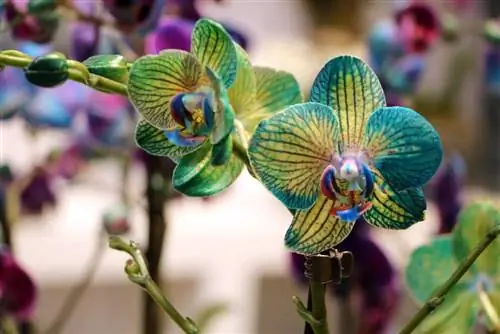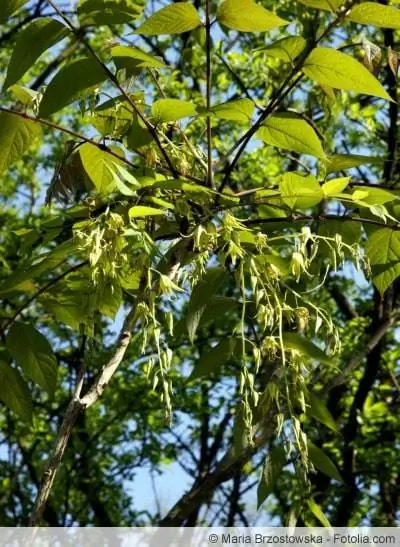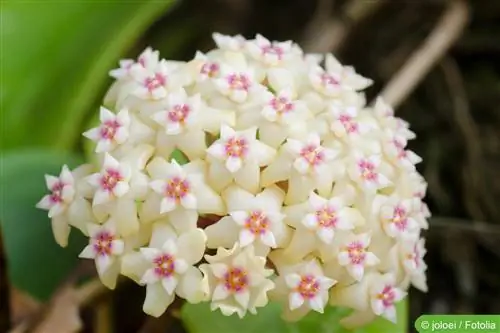- Author admin [email protected].
- Public 2023-12-17 03:39.
- Last modified 2025-06-01 06:48.
The fan flower is a popular balcony plant that looks particularly good in hanging baskets or hanging baskets thanks to its hanging shoots. But the purple to blue flowers also look great in flower boxes, pots and outdoors. Although the decorative plant is considered very easy to care for and robust, there are still a few things to consider when it comes to care.
Profile
- German name: Blue Fan Flower
- Scientific name: Scaevola aemula
- Family: Goodenia family (Goodeniaceae)
- Genus: Fan flowers (Scaevola)
- Flowering period: May to October
- Flower color: violet, blue
- Leaf color: green
- Growth height: 30-50 cm
- Fruit type: egg-shaped drupes
- Frost hardiness: sensitive to frost
Location
The blue fan flower originally comes from tropical and subtropical areas of Australia and Polynesia and is therefore a sun lover. In this country, the Scaevola aemula is a decorative eye-catcher, especially on balconies and terraces, where it is particularly effective in elevated positions. Although it prefers sunny places, it also copes very well with partially shaded locations. It even grows in the shade, although the abundance of flowers there decreases significantly. The ideal location for the plant should therefore meet the following requirements:
- sunny to partially shaded
- the sunnier, the more flowers
- Planting distance about 20 cm
- Wind and rain protection not required
Note:
The Scaevola aemula can be cultivated both on the balcony and in the garden. However, it is not suitable for underplanting trees!
Soil / Substrate
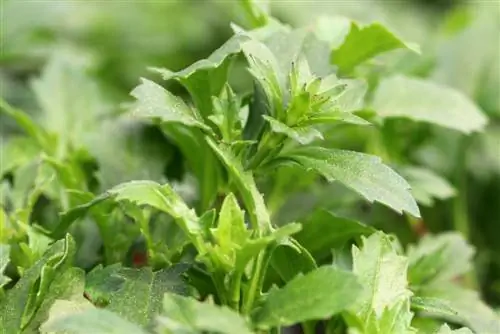
In the wild, Scaevola aemula grows in bush regions and in coastal areas in dry sandy and clay soils. Accordingly, it feels most comfortable in such a substrate in this country. Outdoors, it can usually be used in normal garden soil without any problems, as long as it is as lime-free as possible. Lime builds up in the roots and inhibits the ability to absorb water and nutrients, which in turn harms the he alth of the plant. However, if the plant is grown in a bucket or pot, it needs normal potting soil, which ideally is loosened up. Sand, clay granules, perlite and grit are suitable for this. The ideal substrate or soil is also characterized by the following properties:
- moist
- well drained
- sandy to loamy
Planters
The Scaevola aemula is preferably planted on the balcony or terrace. There are numerous options available to the hobby gardener to showcase the flowers. The fan flower looks particularly beautiful when combined with different varieties. Because they are available in a wide variety of colors, such as the “Sapphire” with blue flowers or the “Crystal” with pure white flowers. Since the plant forms overhanging shoots, it is the ideal candidate for planting hanging baskets. However, their flowers also come into their own in other planters, such as:
- Traffic lights
- Balcony boxes
- Bucket
- Pots
- high plant bowls
Note:
Regardless of the type of planter, it is important that it has a drainage hole.
Planting
The blue fan flower is usually purchased as a young plant from specialist retailers. The plant should be planted quickly after purchase, but it is advisable to first give it a long bath in lime-free water. Old soil residues can also be removed directly in the same move. It is also advisable to line the water drainage hole with drainage. This prevents it from becoming clogged and causing waterlogging. Porous material is best suited for drainage, such as lava grit, fine clay shards or even small pebbles. The following steps have also proven useful for planting:
- Create drainage about 3 cm high
- sufficient soil above it
- Insert plant
- Planting distance approx. 20 cm
Note:
There is usually room for two to three fan flowers in a hanging basket!
Fertilize
Although the decorative plant is not a heavy feeder, it still has a significant nutrient requirement. Accordingly, it is advisable to fertilize the plant at regular intervals. Compost or other organic fertilizers, such as horn shavings, are suitable for the flower bed. However, if the flowers are grown on the balcony, a liquid fertilizer is usually the better choice. Organic substances, such as compost or coffee grounds, cannot be fully processed by the microorganisms in the substrate. To ensure that the plants in the pot are adequately supplied with nutrients, it is best to proceed as follows:
- Administer long-term fertilizer at the beginning of the season
- fertilize every two weeks
- from April to the end of August
- with low dosage
Pouring
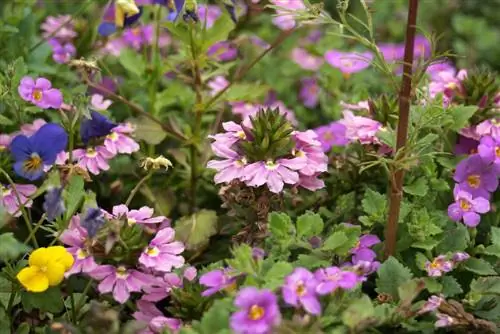
When it comes to irrigation, the fan flower is comparatively undemanding. Since she originally comes from Australia, she is very familiar with heat and short dry periods and can therefore cope well with them. However, the root ball should never dry out, which is why the flower needs to be watered regularly. In order to cover your average water needs, the following points should be taken into account when watering:
- water regularly
- water more or more often in sunny locations
- best with lime-free water
- do not water in the midday sun
- Avoid waterlogging
- additional mulch outdoors
Note:
To prevent the risk of waterlogging, you should always choose planters that have a drain.
Cutting
In terms of pruning work, the fan flower is very easy to care for because pruning is not absolutely necessary. It also sheds dead flowers on its own, which the hobby gardener only has to collect and dispose of. Since new flowers are constantly forming on the ends of the shoots, it can happen that the fan flower gets out of shape. In this case it can be cut back into shape if necessary. This also has the advantage that the plant is stimulated to produce flowers. If you want to go one step further, you can use scissors and cut the plant back by half after the first flowering phase. As a result, the plant sprouts again and even produces more flowers!
Wintering
The fan flower is usually cultivated as an annual because it is very sensitive to frost. However, under certain conditions it can be overwintered and therefore grown for several years. It is important that the plants are moved to a frost-free location - including plants that were planted in borders! To overwinter, these must be dug up, placed in pots and brought to their winter quarters. In order to best prepare the plants for overwintering, it is recommended to first cut them by around two thirds. The plants can then be overwintered as follows:
- Location: bright greenhouse or winter garden
- Temperature: 10 - 15 degrees Celsius
- Pouring: only in moderation
- Fertilize: no
- Avoid heat source and direct sunlight
Note:
After successfully overwintering, the flowers should not be put back outdoors immediately! It is better to get them used to the sun slowly and protect them from the midday sun for the time being.
Propagation
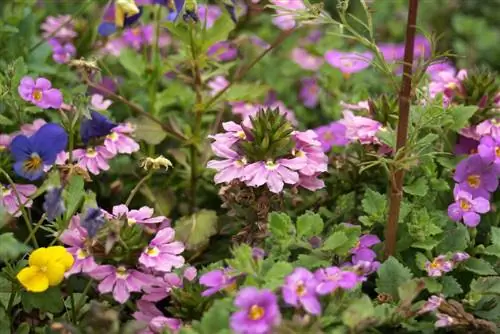
The propagation of fan flowers is a difficult undertaking, which is also very lengthy, taking at least 2.5 months. Unfortunately, propagation is not always successful, which is why the plants are usually propagated by specialist companies and then offered commercially as young plants. If you still want to take on this challenge and try your luck, it's best to try propagation using partial or head cuttings. These should be non-flowering and slightly woody and about 6 - 8 cm long. After these have been taken from the mother plant, the top cuttings are first removed from the leaves except for the two upper pairs of leaves. Committed hobby gardeners can then try propagating as follows:
- Bevel the lower end of the shoots with a knife
- Wet the interface with rooting powder
- Plant cutting 2/3 in soil
- Keep substrate regularly and evenly moist
- Earth must not dry out!
- Also avoid waterlogging
- Location: bright, but not too sunny
- Temperature: 20 - 25 degrees Celsius
Note:
Direct sunlight should be avoided as this dries out the substrate too quickly and the cuttings could become stressed.
Pests and diseases
The Scaevola aemula is not only considered very easy to care for and robust, but it is also comparatively rarely attacked by pests. Only leaf miner flies can trouble it, but they can be identified relatively quickly by their mine-like burrows. If there is an infestation, it is advisable to collect and dispose of the affected leaves and, if necessary, use parasitic wasps. It is also relatively insensitive to diseases. However, caution is advised against wilt diseases, which are usually associated with incorrect irrigation and can therefore often be avoided.


